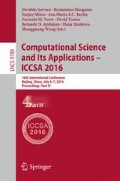Abstract
In this paper a methodology for analyzing the behavior of the environmental noise pollution is proposed. It consists of a mobile application called ‘NoiseMonitor’, which senses the environmental noise with the microphone sensor available in the mobile device. The georeferenced noise data constitute Volunteered Geographic Information that compose a large geospatial database of urban information of the Mexico City. In addition, a Web-GIS is proposed in order to make spatio-temporal analysis based on a prediction model, applying Machine Learning techniques to generate acoustic noise mapping with contextual information.According to the obtained results, a comparison between support vector machines and artificial neural networks were performed in order to evaluate the model and the behavior of the sensed data.
Access this chapter
Tax calculation will be finalised at checkout
Purchases are for personal use only
References
Leuenberger, M., Kanevski, M.: Extreme learning machines for spatial environmental data. Comput. Geosci. 85, 64–73 (2015)
Nil, J.: Managing data ood is industry challenge (2005)
Al-Jarrah, O.Y., Yoo, P.D., Muhaidat, S., Karagiannidis, G.K., Taha, K.: Efficient machine learning for big data: a review. Big Data Res. 2(3), 87–93 (2015)
Rathore, M.M., Ahmad, A., Paul, A., Rho, S.: Urban planning and building smart cities based on the internet of things using big data analytics. Comput. Netw. 101, 63–80 (2016)
Torres-Ruiz, M., Lytras, M.D.: Urban computing and smart cities applications for the knowledge society. Int. J. Know. Soc. Res. 7(1), 113–119 (2016)
Sekimoto, Y., Shibasaki, R., Kanasugi, H., Usui, T., Shimazaki, Y.: Pflow: reconstructing people flow recycling large-scale social survey data. IEEE Pervasive Comput. 4, 27–35 (2011)
Zheng, Y., Capra, L., Wolfson, O., Yang, H.: Urban computing: concepts, methodologies, and applications. ACM Trans. Intell. Syst. Technol. 5(3), 38–96 (2014)
Liu, T., Zheng, Y., Liu, L., Liu, Y., Zhu, Y.: Methods for sensing urban noises. Technical report. MSR-TR-2014–66 (2014)
Bulter, D.: Noise management: sound and vision. Nature 5, 280–481 (2004)
Wang, Y., Zheng, Y., Liu, T.: A noise map of New York City. In: Proceedings of the ACM International Joint Conference on Pervasive and Ubiquitous Computing: Adjunct Publication, pp. 275–278. ACM (2014)
Ross, Z., Kheirbek, I., Clougherty, J.E., Ito, K., Matte, T., Markowitz, S., Eisl, H.: Noise, air pollutants and traffic: continuous measurement and correlation at a high-traffic location in New York City. Environ. Res. 111, 1054–1063 (2011)
Martí, I.G., Rodríguez, L.E., Benedito, M., Trilles, S., Beltrán, A., Díaz, L., Huerta, J.: Mobile application for noise pollution monitoring through gamification techniques. In: Herrlich, M., Malaka, R., Masuch, M. (eds.) ICEC 2012. LNCS, vol. 7522, pp. 562–571. Springer, Heidelberg (2012)
Torija, A.J., Ruiz, D.P.: A general procedure to generate models for urban environmental-noise pollution using feature selection and machine learning methods. Sci. Total Environ. 505, 680–693 (2015)
Zuo, F., Li, Y., Johnson, S., Johnson, J., Varughese, S., Copes, R., Liu, F., Wu, H.J., Hou, R., Chen, H.: Temporal and spatial variability of traffic-related noise in the City of Toronto. Can. Sci. Total Environ. 472, 1100–1107 (2014)
D’Hondt, E., Stevens, M., Jacobs, A.: Participatory noise mapping works! an evaluation of participatory sensing as an alternative to standard techniques for environmental monitoring. Pervasive Mob. Comput. 9(5), 681–694 (2013)
Acknowledgments
This work was partially sponsored by the Instituto Politécnico Nacional (IPN), the Consejo Nacional de Ciencia y Tecnología (CONACYT), and the Secretaría de Investigación y Posgrado (SIP) under grant 20162006.
Author information
Authors and Affiliations
Corresponding author
Editor information
Editors and Affiliations
Rights and permissions
Copyright information
© 2016 Springer International Publishing Switzerland
About this paper
Cite this paper
Torres-Ruiz, M., Juárez-Hipólito, J.H., Lytras, M.D., Moreno-Ibarra, M. (2016). Environmental Noise Sensing Approach Based on Volunteered Geographic Information and Spatio-Temporal Analysis with Machine Learning. In: Gervasi, O., et al. Computational Science and Its Applications -- ICCSA 2016. ICCSA 2016. Lecture Notes in Computer Science(), vol 9789. Springer, Cham. https://doi.org/10.1007/978-3-319-42089-9_7
Download citation
DOI: https://doi.org/10.1007/978-3-319-42089-9_7
Published:
Publisher Name: Springer, Cham
Print ISBN: 978-3-319-42088-2
Online ISBN: 978-3-319-42089-9
eBook Packages: Computer ScienceComputer Science (R0)

